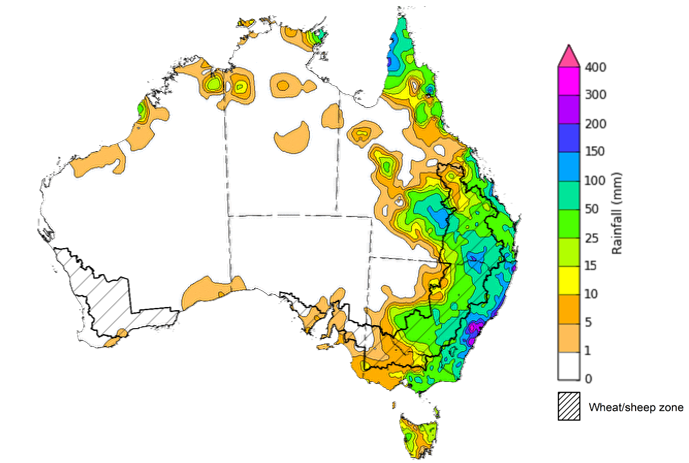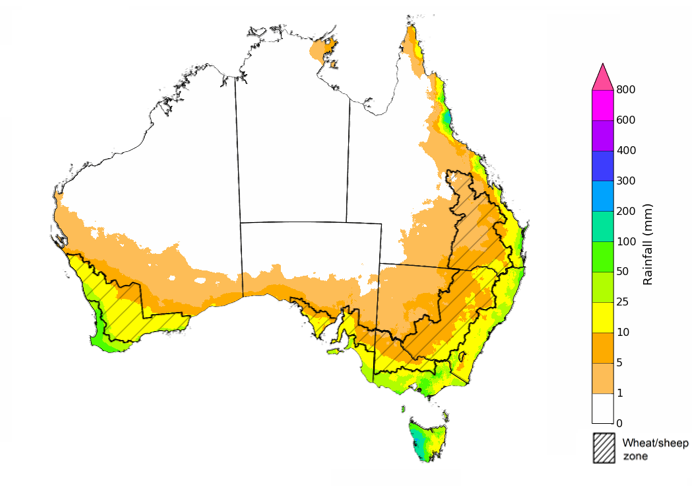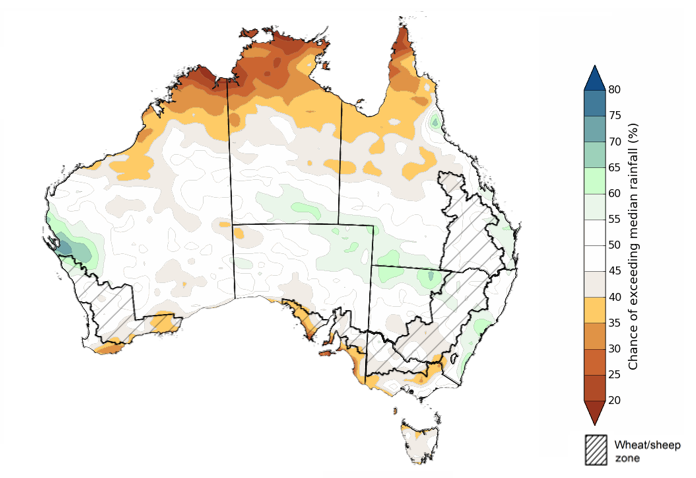Key issues
- In the week ending 11 April 2024, large areas in the eastern Australia were affected by a severe weather system with recorded rainfall of up to 200 millimetres in southern Queensland and 400 millimetres in New South Wales.
- Cropping regions in Queensland and New South Wales will benefit from boost in soil moisture levels required for winter crops and pasture growth.
- However, this rainfall would have affected the harvest of sorghum and the quality of the crops in Queensland.
- Over the coming days, a monsoon trough, a tropical low and onshore winds will bring showers and storms to parts of northern, western and eastern Australia. A high-pressure system will keep much of the country dry.
- A dry week in Queensland cropping regions will allow for the resumption of harvest of summer crops in the coming weeks.
- Much of New South Wales, southern Queensland and eastern Victoria have received an early autumn break with rainfall of at least 30 millimetres over any 7 days in March/early April. If this break is consolidated by follow-up rainfall in April, these regions will be in an ideal position for winter crop plantings.
- The national rainfall outlook is for equal chances of above or below median rainfall for much of Australian cropping regions over the next three months.
- Considering recent rainfall, particularly in eastern Australia, these falls are likely to be sufficient to facilitate the sowing and establishment of winter crops.
- Water storage levels in the Murray-Darling Basin (MDB) increased between 4 April 2024 and 11 April 2024 by 43 gigalitres (GL). Current volume of water held in storage is 16 971 GL, equivalent to 76% of total storage capacity. This is 15 percent or 2928 GL less than at the same time last year.
- Allocation prices in the Victorian Murray below the Barmah Choke decreased from $23 on 4 April 2024 to $22 on 11 April 2024. Prices are lower in the Murrumbidgee due to the binding of the Murrumbidgee export limit.
Climate
For the week ending 10 April 2024, a low-pressure system and a series of troughs brought rainfall totals of up to 400 millimetres in eastern New South Wales and up to 200 millimetres in southern Queensland. Tropical cyclone Olga formed off the coast of northern Western Australia, resulting in over 100 millimetres of rainfall in isolated areas. Additionally, troughs in the northern tropics brought up to 200 millimetres of rainfall in north Queensland.
In cropping regions, rainfall totals reached up to 200 millimetres in Queensland and 150 millimetres in New South Wales. A high-pressure system in the south kept Western Australia and parts of South Australia dry. A lack of rainfall in cropping areas in the south are likely to lead to a reduction in stored soil moisture for winter crops.
In addition to high rainfall interrupting the harvest of late season summer crops, it would have further impacted the quality of the crops, particularly of sorghum in Queensland.
Rainfall for the week ending 10 April 2024

Issued: 10/04/2024
Note: The rainfall analyses and associated maps utilise data contained in the Bureau of Meteorology climate database, the Australian Data Archive for Meteorology (ADAM). The analyses are initially produced automatically from real-time data with limited quality control. They are intended to provide a general overview of rainfall across Australia as quickly as possible after the observations are received. For further information go to http://www.bom.gov.au/climate/rainfall/
Over the 8 days to 18 April 2024, monsoon lows and storms are expected to generate rainfall of up to 100 millimetres across northern parts of Northern Territory and Queensland, potentially more across isolated parts of the north Queensland coast. A tropical low is expected to result in showers in western parts of Western Australia and onshore winds are expected to generate falls of up to 50 millimetres in eastern New South Wales. High pressure systems are expected to keep the central and southern parts of the country largely dry.
Across cropping regions, conditions are expected to be generally dry, with a maximum of 10 millimetres forecast for Queensland and New South Wales. With the harvest of summer crops underway in Queensland, these mainly dry conditions would facilitate the resumption of harvest activities following 2 weeks of heavy rainfall.
Victoria and South Australia are likely to receive no rainfall over the period due to a high-pressure system developing in the Great Australian Bight. This continues to present a risk of declining soil moisture levels in these areas. A similar reduction in soil moisture would be expected in Western Australia, where a maximum of only 5 millimetres of rainfall is expected.
Total forecast rainfall for the period 11 April to 18 April 2024

Issued 11/04/2024
Note: This rainfall forecast is produced from computer models. As the model outputs are not altered by weather forecasters, it is important to check local forecasts and warnings issued by the Bureau of Meteorology.
In southern Australia, the timing of the autumn break is an important factor for a successful pasture and crop production season. The autumn break is the first significant rainfall of the winter growing season and provides enough moisture to initiate crop and pasture germination and support early plant growth. The break generally applies to the southern pasture and cropping areas mainly in New South Wales, Victoria, South Australia, Western Australia and Tasmania — and occasionally parts of southern Queensland.
Areas likely to be influenced by the autumn break

An early autumn break can increase the length of the growing season, potentially improving production and yield. The definition of the autumn break in southern Australia varies. Pook et al. (2009) suggested an ideal break for north-western Victoria occurs during March–June when a mean fall of 25 millimetres or more is recorded over a period of 3 days or less, or when a mean fall of 30 millimetres or more is recorded over a period of 7 days or less.
The timing of the autumn break early of late can have an influence on the production outcome of the upcoming winter growing season. However, the consolidation of this break with timely follow-up falls is important in determining the ultimate benefits of the autumn break. For example, a 30mm rainfall event over a period of 7 days or less in March followed by warm, dry weather during April is likely to constitute a ‘false’ break and can have a net negative impact on production. An early autumn break in and of itself does not guarantee a successful growing season; sufficient winter and spring rainfall is still required, particularly in areas with little to no stored soil moisture, to deliver a successful crop and pasture production season.
Southern pasture and cropping areas that have achieved 30 millimetres in any 7‐day period from 1 March to 7 April 2024

ABARES has adapted the Pook et al. (2009) autumn break definition of falls of 30 millimetres or more recorded within any 7-day period from 1 March to identify where the autumn break threshold has been achieved across southern Australia.
ABARES analysis of daily rainfall data sourced from the Bureau of Meteorology indicates that the autumn break has been achieved across most cropping regions of central to southern New South Wales, parts of southern Queensland and eastern Victoria, northern Tasmania and areas in the central to eastern Western Australia. Typically, the autumn break is driven by westerly fronts moving across southern Australia and cut-off low pressure systems. This early autumn break where recorded were from a sequence of troughs.
The most recent rainfall outlook for May 2024 provided by the Bureau of Meteorology indicates a high likelihood (60 to 80% chance) of below-median rainfall across a significant portion of Australia. Notable exceptions being Tasmania, along with coastal New South Wales and eastern Queensland, south- western parts of Western Australia and southern Victoria, which are showing an equal probability of below or above median rainfall.
According to Bureau of Meteorology’s climate model, for May 2024 there is a 75% probability of rainfall totals exceeding 25 millimetres in coastal eastern and southern Australia, as well as in western Tasmania and southern Victoria. Northeastern coastal Queensland and western Tasmania are anticipated to receive rainfall totals surpassing 50 millimetres.
Within cropping regions, there is at least 75% chance of rainfall totals of up to 25 millimetres in Western Australia, much of South Australia, and along the eastern fringes of New South Wales and southern Victoria and Queensland. By contrast, May rainfall totals for the remaining cropping regions have a 75% chance of being up to 10 millimetres.
Across parts of eastern Australia, particularly in South Australia and western Victoria, these falls which would be considered well below average for this time of year are likely to result in an increased disconnect between upper- and lower-layer soil moisture, meaning that there would be limited opportunities to plant winter crops under ideal conditions. This may see many grain producers opt to dry sow crops, which presents some production risk outcomes if rainfall is not sufficient to support germination and establishment, until plant roots are able to tap into stored lower layer soil moisture.
Rainfall totals that have a 75% chance of occurring in May 2024

Issued: 11/04/2024
The 2023–24 El Niño event continues to decay, with the anticipation of return to a neutral El-Niño Southern Oscillation (ENSO) condition in the current 2024 autumn. The rainfall outlook for May through July 2024 indicates above median rainfall is likely in the western part of Western Australia, central and eastern coastal parts of the country. Below median rainfall is likely in the northern Tropics and parts of southern coasts. Equal chances of above or below median rainfall is likely in the remaining Australia.
Across cropping regions, the probability of exceeding median rainfall is between 40 and 60%.
Chance of exceeding the median rainfall May to July 2024

Issued: 11/04/2024
The outlook for May to July 2024 suggests there is at least 75% chance of rainfall exceeding 25 millimetres throughout much of southern and eastern Australia, with notable exceptions in large sections of the interior and northern regions where rainfall below 25 millimetres is more likely. Along Australia’s eastern and southern coastline, as well as in Tasmania, rainfall totals in excess of 200 millimetres are expected during this period.
Across cropping regions, there is at least a 75% chance of receiving between 25 and 200 millimetres. Considering the recent declines in upper layer soil moisture levels, particularly in South Australia, Western Australia and western parts of Victoria, sufficient and timely rainfall will be required in the coming months to facilitate the sowing and establishment of winter crops. While below average falls are forecast across a number of regions during May, a more positive outlook of June and July should provide sufficient moisture to the germination of dry sown crops and follow up winter crop planting towards the end of the ideal planting window.
Livestock producers, especially those in southern Australia, are expected to experience close to average pasture production on the back of the improved rainfall outlook over the May to July period. Additionally, the availability of accumulated standing dry matter and ample conserved fodder is likely to enable most producers to maintain current production levels and stocking rates.
Rainfall totals that have a 75% chance of occurring May to July 2024

Issued: 11/04/2024
Water
Water storages, water markets and water allocations - current week
The Tableau dashboard may not meet accessibility requirements. For information about the contents of these dashboards contact ABARES.
Commodities
Information on weekly price changes in agricultural commodities is now available at the Weekly commodity price update.
